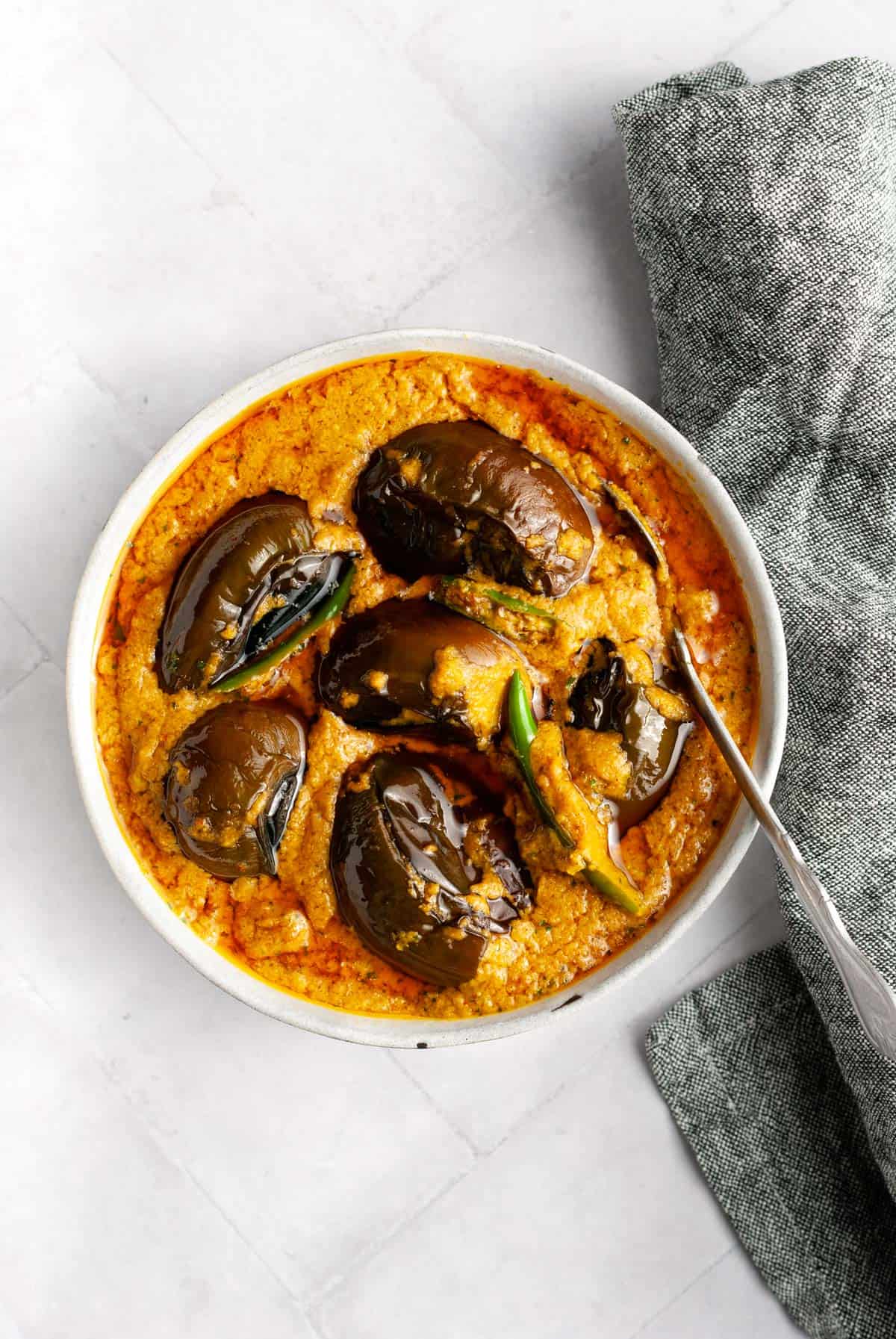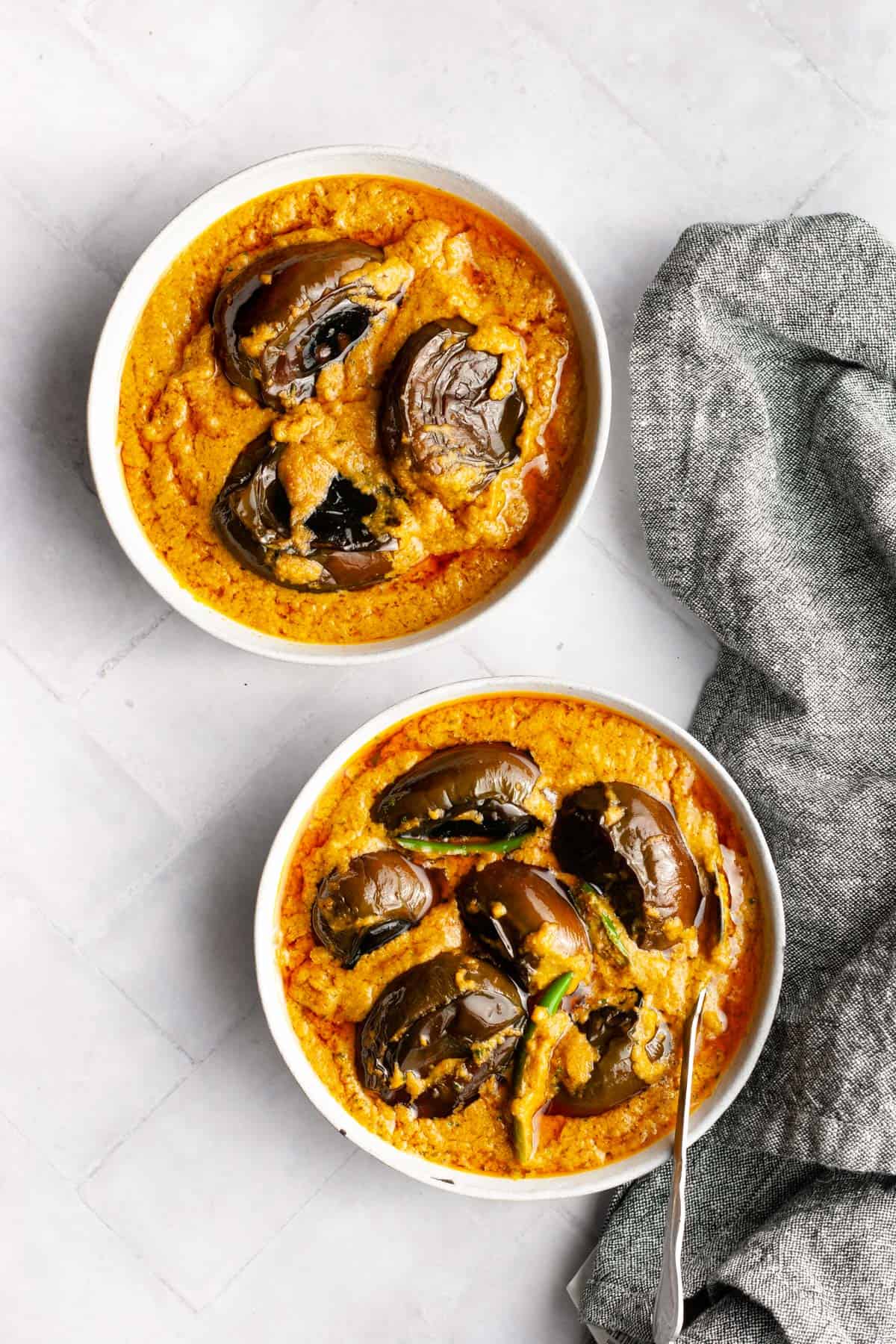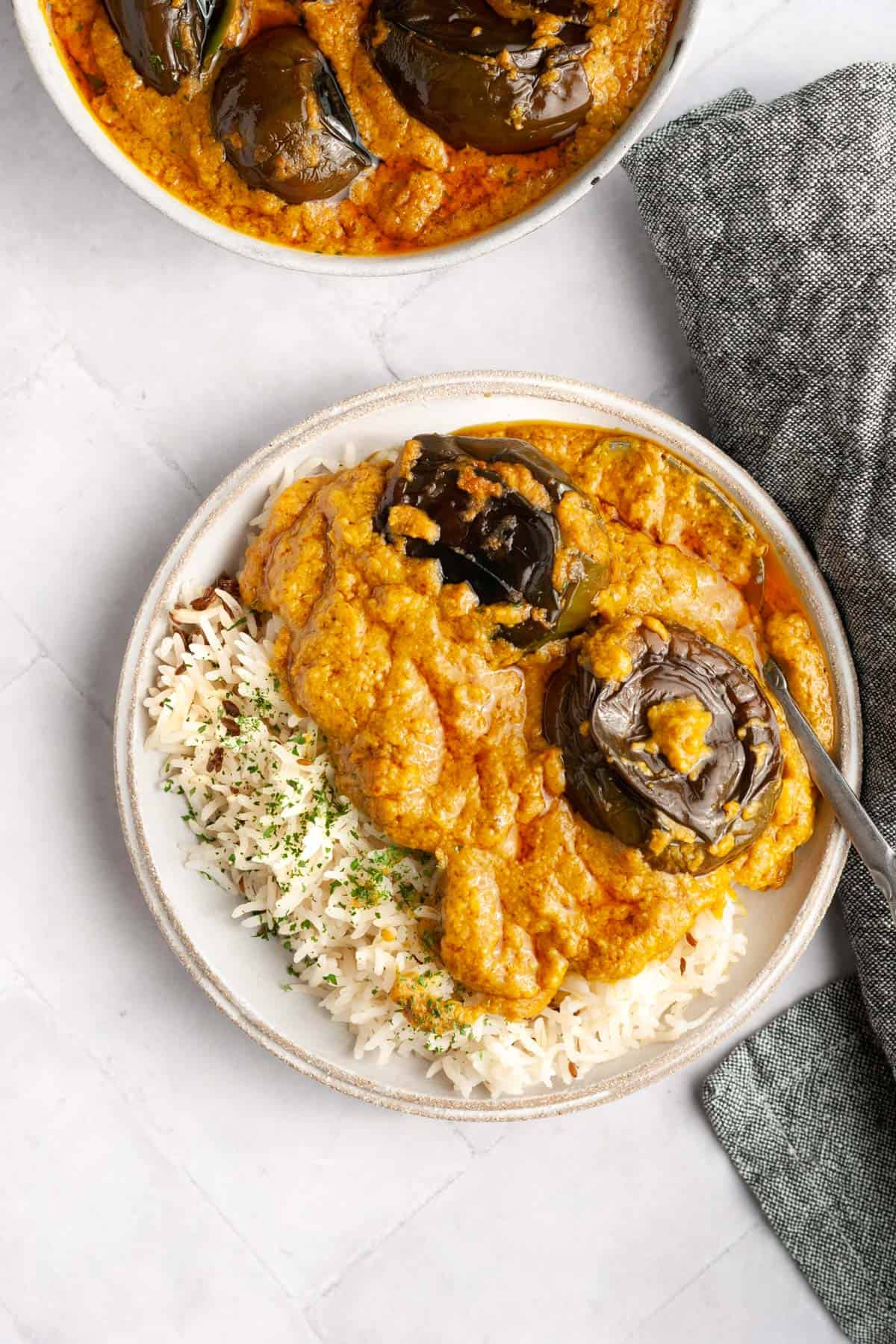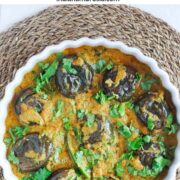This bagara baingan recipe is a delicious Hyderabadi style eggplant curry with tamarind, peanuts, sesame and coconut. It has some great layers of flavor and tastes wonderful with both bread and rice.

Bagara baingan or baghare baingan is right up your alley if you love tangy Indian curries. It is also called Hyderabadi bagara baingan since it is a specialty from Hyderabad in South India. The spices and masalas used in the southern states of India differ significantly from those in the North. Think tamarind, coconut, peanuts and curry leaves, all liberally used ingredients in dishes down South, but hardly ever used in North Indian cuisine. That was my little nugget about the difference in cooking styles within India.
This happens to be an authentic recipe as I learnt it from my cousin, Asma, whose husband is from Hyderabad. She makes the most delish Hyderabadi style baghare baingan, so I know it's an original recipe. I love the tangy, mildly spicy salan and it is such a welcome change from my typical gravies.
Serve bagara baingan with any Indian bread of your choice or white Basmati rice. And some people adore this curry as a side with biryani. Here's an egg biryani (another gem from Hyderabad!) and a chicken biryani if you can't fathom biryani without meat:)
Ingredients
Note: Exact amounts are mentioned in the recipe card further down.
- Tamarind
- Cooking oil
- Baby eggplants
- Red onion
- Peanuts, unsalted
- Sesame seeds
- Dry desiccated coconut, unsweetened
- Cumin seeds
- Ginger paste
- Garlic paste
- Coriander powder
- Turmeric powder
- Kashmiri chilli powder - I like to use Kashmiri chilli (affiliate link) in my curries as it is milder than regular chilli. It is also naturally bright red and imparts a pleasing color to anything it's added to. Since you're also adding Thai green chillies (which are quite hot), Kashmir chilli powder is perfect for this recipe. If you can't find it, however, use regular chilli but reduce the quantity by half.
- Thai green chillies
- Cilantro leaves (optional)
- Sea salt

Instructions
Time needed: 1 hour
How to make bagara baingan
1. Make the tamarind water
- Put the tamarind into a small bowl and pour one cup hot water in it. Let the tamarind soak in hot water for 15-20 minutes as you go about the other tasks.
- After about 20 minutes, pass the mixture through a tea strainer to get tamarind water. You can discard the solids left behind.
2. Fry the baby eggplants in cooking oil
- Cut off the tops of all the eggplants and make deep vertical slits without slicing them in half. This is so the spices can penetrate inside.
- Heat half the cooking oil in a dutch oven and fry the eggplants until they soften a little (5 minutes). There's no need to cook them fully as you will be cooking them in the curry later.
3. Fry the onions
- In the same oil that you fried the eggplant, add the sliced onions and fry them until reddish brown. Take them out with a slotted spoon and keep them aside.
- If you want to save time, you can use one cup pre-fried onions too, easily available in any Indian or Pakistani grocery.
4. Make the wet masala for the curry
- Take a small frypan and set it on medium heat. Add the peanuts and dry roast them until they turn slightly dark in color. You will need to stir them with a spoon as they are browning. After about a minute, remove them from the heat and onto a plate.
- Repeat this step with the sesame seeds, cumin seeds, and coconut, taking care to roast them one by one and not all together.
- When these spices cool down a bit, add them to a blender along with the fried onions. Add a few tablespoons of the tamarind water (step 1) and blend. The mixture will be quite thick so keep adding the tamarind water as you are blending to get a smooth paste. Your wet masala is ready.
5. Fry the ginger and garlic
- Add the remaining oil to the dutch oven and tip in the ginger and garlic pastes.
- Add the powdered spices (coriander, turmeric, and red chilli) and salt and a couple tablespoons water. Fry for about two minutes.
6. Add the wet masala
- Add the wet masala you prepared in step 4 and half cup water. Stir well with a spoon and cover with a lid. Cook this for about 10-12 minutes on medium heat.
7. Add the eggplants
- Add the previously fried eggplants, green chillies, and some more water if required. Cover and cook for 20 minutes on low to medium heat.
- Once the eggplants are soft and the oil separates, your dish is ready.
- Garnish with cilantro leaves if using and serve hot with bread or rice.

Top tips
- If you want to control the sourness of the curry, don't add the tamarind water to the wet masala. Add water instead to blend it, and use the tamarind water while you are cooking the curry. This way, you can taste as you go and add only as much tamarind as you like.
- Do cook the curry for the time specified. The full flavor and taste of any curry depends on how well you cook it. A good test of the doneness is to check the smell and appearance. It is done when that raw, slightly sharp smell of the spices, ginger and garlic goes and is replaced by a fragrant aroma instead. Also, the oil will separate and float on the top. This is called the 'bhuna' stage. If you want to know more about some Indian cooking techniques in detail, do read this post: 5 Indian Cooking Techniques. It has tips on how to fry onions properly, how to cook in the dum style etc.
- Want to make your life easier? Use store-bought fried onions and ginger and garlic pastes. Sometimes, when I'm in a hurry, I use these.
More vegetarian curries you might like
- Paneer jalfrezi - A colorful vegetarian stir fry made with cottage cheese, onions, tomatoes, green peppers, and powdered spices. On the table in 20 minutes.
- Butternut squash and chickpea curry - This curry has spinach too, so if you like the idea of wholesomeness in a bowl, this is the one for you!
- Mushroom masala - This one's for mushroom lovers. If you like mushrooms, you will adore this curry made rich with cashews.
- Paneer butter masala - Another finger-lickin' good nutty-buttery curry with soft cottage cheese cubes.
- Aloo curry - This vegan potato curry tastes awesome with puri, a crisp and puffy Indian bread.
For more vegetarian options, check out the entire collection of vegetarian recipes on the blog.
📖 Recipe

Bagara Baingan Recipe (Hyderabadi Eggplant Curry)
Equipment
- Small frypan
- Blender
- Dutch oven
Ingredients
- ¼ cup seedless tamarind
- 6 tablespoon cooking oil divided
- 10 baby eggplants tops cut off and slit lengthwise
- 1 red onion big, sliced finely
- ¼ cup peanuts shelled
- 3 teaspoon sesame seeds
- 1 teaspoon cumin seeds
- 3 tablespoon dessicated coconut unsweetened
- 2 tablespoon ginger paste
- 2 tbsp garlic paste
- 1 tablespoon coriander powder
- 1 teaspoon turmeric powder
- 1 teaspoon sea salt
- 1 teaspoon Kashmiri chilli powder
- 2 green chillies
- 2 tablespoon cilantro leaves chopped
Instructions
- Put the tamarind in a small bowl and pour one cup hot water in it. Let the tamarind soak in hot water for 15-20 minutes as you go about the other tasks. After about 20 minutes, pass the mixture through a tea strainer to get tamarind water. You can discard the solids or seeds left behind.
- Cut off the tops of all the eggplants and make deep vertical slits without slicing them in half. Heat half the cooking oil (3 tbsp) in a dutch oven and fry the eggplants until they soften a little (5 minutes).
- In the same oil that you fried the eggplant, add the sliced onions and fry them until reddish brown. Take them out with a slotted spoon and keep them aside.
- Take a small frypan and set it on medium heat. Add the peanuts and stir them with a spoon until they turn golden. After about a minute, remove them from the heat and onto a plate. Repeat this step with the sesame seeds, cumin seeds, and coconut, taking care to roast them one by one and not all together. There's no need for oil in this step.
- Add the above to a blender along with the fried onions and a few tablespoons of the tamarind water (step 1) and blend. The mixture will be quite thick so keep adding the tamarind water as you are blending to get a smooth paste. Your wet masala is ready.
- Heat the remaining 3 tablespoon oil and and tip in the ginger and garlic pastes. Add the powdered spices (coriander, turmeric, and Kashmiri red chilli) and salt and a couple tablespoons water. Fry for about two minutes.
- Add the wet masala you prepared in step 5 above and half a cup water. Stir well with a spoon and cover with a lid. Cook this for about 10-12 minutes on medium heat.
- Add the previously fried eggplants, green chillies, and some more water if required. Cover and cook for 20 minutes on low to medium heat. Once the eggplants are soft and the oil separates, your dish is ready. Garnish with cilantro leaves if using and serve hot with bread or rice.
Notes
- Most of the ingredients mentioned in the recipe can be found online or in your local Indian and Pakistani groceries.
- Kashmiri chilli is a mild variety of chilli powder. It has a natural fiery red color which is very appealing in curries. If you can't find it, use regular red chilli but reduce the quantity by half.
- If you are in a hurry, you can use store-bought fried onions and ginger and garlic pastes. One cup of pre-fried red onions will work in this recipe.
- If you want to control the sourness of the curry, don't add the tamarind water to the wet masala. Add plain water instead to blend it, and use the tamarind water while you are cooking the curry. This way, you can taste as you go and add only as much tamarind as you like.


Robin says
This was a great recipe.
Made it last night and enjoyed it thoroughly. Thanks for the recipe.